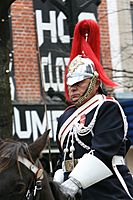Albert helmet facts for kids
The Albert helmet is a special kind of helmet. The British military started using it in the 1800s. It was designed for soldiers called dragoons, who were cavalry (soldiers on horseback).
Prince Albert, who was Queen Victoria's husband, created this helmet in 1842. The Household Cavalry, a special group of British soldiers, first wore it in 1843. By 1847, other heavy cavalry units across the British Empire also began to use it.
Today, the Albert helmet is still worn. It is part of the fancy "full dress" uniform. Several British and Canadian cavalry regiments use it. This includes the Blues and Royals and the Life Guards in Britain. In Canada, the Royal Canadian Dragoons, Lord Strathcona’s Horse, and Governor General's Horse Guards wear it.
History of the Albert Helmet
The Albert helmet was named after Prince Albert. He was the husband of Queen Victoria. He designed it in 1842. This metal helmet was inspired by helmets worn by cavalry in the Prussian Army.
The Household Cavalry started wearing it in 1843. It replaced their old helmets. Other heavy cavalry regiments began using it in 1847.
The helmet was made of metal. Officers had gilt (gold-colored) helmets with silver parts. Other soldiers had brass helmets with white metal parts. A spike was on top, holding a plume (a feathery decoration).
The plumes were different for each regiment. The Royal Horse Guards wore a red plume. The 1st (Royal) Regiment of Dragoons wore black. The two Life Guards regiments both wore white plumes. The 1st Regiment's plume fell normally. The 2nd Regiment's plume was gathered into a ball, like an "onion," before falling.
Most people liked the new helmet. One person called it "handsome, light and convenient." The United Service Gazette said it was "light, fits well to the head" and offered good protection. However, it was not popular for hard work. Soldiers often wore a simpler Kilmarnock cap instead.
The helmet was changed in 1865. This was because of lessons learned from the Indian Mutiny and Crimean War. The new helmet was less fancy. The Household Cavalry still uses this updated design for their full dress uniform.
The Albert helmet was also worn by many cavalry regiments in the Canadian Militia in the past.
Who Wears the Albert Helmet Today?
The helmet is still used by the two Household Cavalry regiments today. These are the Blues and Royals and the Life Guards. These regiments were formed by combining older ones.
The Life Guards still have the white plume with the "onion" shape. The Blues and Royals use the red plume. For most soldiers, the plume is about 20 inches (51 cm) long. It is made from horsehair or nylon. Officers have slightly different plumes. Life Guards officers have an 18-inch (46 cm) horsehair plume. Blues and Royals officers have a 17-inch (43 cm) yak hair plume.
Special soldiers called Farriers wear different plumes. Life Guards farriers wear black plumes. Blues and Royals farriers wear red plumes.
The regiments also wear the chin strap differently. The Blues and Royals wear it under their chin. The Life Guards wear it under their lower lip. The helmet is now white metal for all ranks. Both regiments wear the same helmet plate (a badge on the front).
The Albert helmet is only worn for special events. This includes parades and formal ceremonies. Medical and veterinary officers do not wear this helmet. They wear a different type of hat.
The soldiers in the Mounted Band of the Household Cavalry wear the helmet for full dress. However, when the royal family is present, they wear different hats. Band officers always wear Albert helmets on these occasions.
In the Canadian Army, the Albert helmet is worn by three regiments. These are The Royal Canadian Dragoons, Lord Strathcona’s Horse, and The Governor General's Horse Guards. They wear it as part of their full dress uniform.




